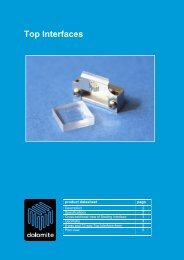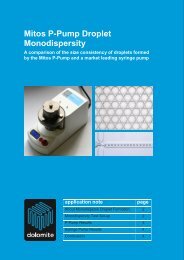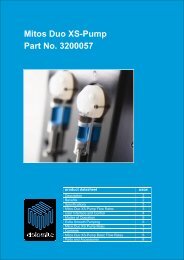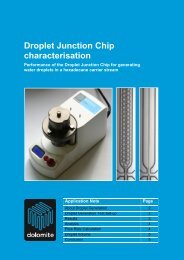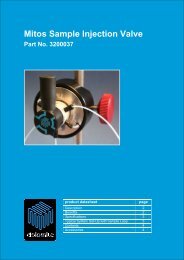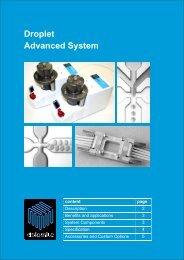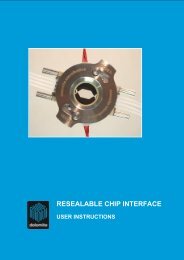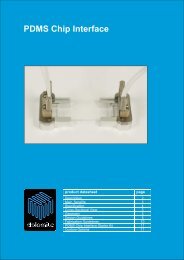application note - Dolomite Microfluidics
application note - Dolomite Microfluidics
application note - Dolomite Microfluidics
You also want an ePaper? Increase the reach of your titles
YUMPU automatically turns print PDFs into web optimized ePapers that Google loves.
The <strong>Dolomite</strong> Centre Ltd<br />
Unit 1, Anglian Business Park, Orchard Road,<br />
Royston, Hertfordshire, SG8 5TW, UK<br />
T: +44 (0)1763 242491<br />
F: +44 (0)1763 246125<br />
E: sales@dolomite-microfluidics.com<br />
W: www.dolomite-microfluidics.com<br />
<strong>Dolomite</strong> <strong>Microfluidics</strong> – North America Office<br />
Blacktrace Inc, 29 Albion Place<br />
Charlestown, MA 02129, USA<br />
C: 617 803 6655<br />
T: 617 848 1121<br />
F: 617 500 0136<br />
E: salesus@dolomite-microfluidics.com<br />
Miniaturisation of Gas<br />
Chromatography Equipment for<br />
Environmental Testing<br />
The microfabrication of a glass Gas Chromatography chip<br />
<strong>application</strong> <strong>note</strong><br />
page<br />
About Gas Chromatography 2<br />
Microfabrication of a Gas<br />
Chromatography Chip<br />
2<br />
Gas Chromatography Analysis 3<br />
Conclusion 5<br />
The <strong>Dolomite</strong> Centre Limited Page 1 of 6
The <strong>Dolomite</strong> Centre Ltd<br />
About Gas Chromatography (GC)<br />
Gas Chromatography (GC) is a highly sensitive chemical analysis technique with a broad<br />
range of <strong>application</strong>s. Existing commercial GC systems are generally quite bulky and<br />
fragile. A key part of a GC system is the GC column. In operation, samples are passed<br />
through the GC column, where they separate out into chemical components. The<br />
separated components then pass through a detector, and a chromatogram is produced<br />
which is used to identify the various chemical components. A typical GC column consists<br />
of a capillary wound onto a spindle which is heated in a turbulent fan oven. The GC<br />
column is normally coated with a ‘stationary phase’ to aid separation.<br />
For environmental testing, in particular atmospheric monitoring, there is a requirement for<br />
portable, robust, low power gas chromatography systems. <strong>Microfluidics</strong> enables<br />
miniaturisation of the gas chromatography column and low power methods for column<br />
heating.<br />
Microfabrication of a glass Gas Chromatography chip<br />
The fabrication of the <strong>Dolomite</strong> GC chip involved wet (isotropic) etching of two glass<br />
wafers. This resulted in open channels in each layer with semicircular cross section.<br />
Holes were then drilled in one of the wafers for fluid access. The wafers were then<br />
diffusion bonded together (without the use of adhesives). Following the diffusion bonding<br />
process, the thickness of the base glass layer was reduced to 300µm, to improve the rate<br />
of heat transfer to the channels. Figure 1 below shows the chip with a <strong>Dolomite</strong> Mitos<br />
edge connector for making a connection to PEEK fluid pipes.<br />
Figure 1 - 100mm x 100mm glass Gas<br />
Chromatography chip with Mitos fluid connector<br />
The chip design included an injection zone along with 7.5 meter and 1.4 meter long<br />
channels with 320µm internal diameter. These channels replace the wound capillary that<br />
is used for existing GC columns. <strong>Dolomite</strong> successfully overcame the challenge in the<br />
photolithography and etching processes, which required the chip footprint area of 100mm<br />
x 100mm area to be manufactured without any defects between channels.<br />
Miniaturisation_of_Gas_Chromatography_ Equipment_ -_ <strong>application</strong> <strong>note</strong>.doc Page 2 of 6
The <strong>Dolomite</strong> Centre Ltd<br />
Earlier microfluidic GC chips were fabricated in Silicon with a square channel crosssection.<br />
These channels suffer from problems with uneven <strong>application</strong> of the coating. The<br />
<strong>Dolomite</strong> chip has a near circular cross section (Figure 2) with accurate alignment of the<br />
two chip layers. This allows the stationary phase to be applied evenly to the inside surface<br />
of the channels.<br />
Fuse line<br />
Figure 2<br />
Chip sectioned to show<br />
near-circular channel<br />
cross section (320µm<br />
diameter)<br />
Figure 3 below shows a constriction etched into in the channel. This constriction allowed<br />
activated carbon particles to be loaded in the area shown in Figure 4, and retained by the<br />
constriction, forming a sample absorption column in the injection zone of the chip.<br />
Carbon particle<br />
loading port<br />
Figure 3 - 320µm diameter channel with<br />
50µm constriction<br />
Figure 4 - Sample absorption column area<br />
Gas Chromatography Analysis<br />
Gas Chromatography requires independent heating and cooling of the two on-chip<br />
columns and the injection zone. Direct column heating and cooling was achieved using a<br />
combination of resistive heaters and Peltier devices. The low thermal conductivity of glass<br />
allowed for multiple uniform temperature zones within a single glass chip. Temperature<br />
control over the range 10–200°C was achieved. Peak power demand was approximately<br />
25W, two orders of magnitude less than a conventional turbulent fan oven. Figure 5<br />
shows the temperature profile under the 300µm thick chip layer:<br />
Miniaturisation_of_Gas_Chromatography_ Equipment_ -_ <strong>application</strong> <strong>note</strong>.doc Page 3 of 6
The <strong>Dolomite</strong> Centre Ltd<br />
Figure 5 - Measured temperature profile (on left) with the 7.5m column heated to<br />
100°C, all other areas left at ambient. Measured temperature profile (on right) with<br />
the 7.5m column cooled to 10ºC whilst holding the temperature of the 1.4m column at<br />
100◦C. The temperature remained uniform (±2°C) over the 7.5m column and the<br />
unheated area remained at ambient temperature.<br />
For detection of the separated components a standard FID (Flame Ionization Detector)<br />
and a lightweight 100mW PID (Photoionization Detector) were coupled to the column.<br />
Column performance was tested with gas mixtures of monoaromatic and mo<strong>note</strong>rpene<br />
species at the parts per million (ppm) concentration level. The low power GC-PID device<br />
showed good performance for a small set of VOCs (Volatile Organic Compounds) and<br />
sub ng detection sensitivity to monoaromatics. Figure 6 shows a chromatogram of the<br />
separated components of the gas mixture.<br />
Figure 6 - Chromatogram showing separation of the 10ppm BTEX standard gas<br />
mixture. 0.5mL sample loop in combination with the planar glass 7.5m GC<br />
column programmed from 10 to 100◦C at 20◦C/min heated using Peltier and<br />
resistive elements. Detection is by low power photoionization detector.<br />
Miniaturisation_of_Gas_Chromatography_ Equipment_ -_ <strong>application</strong> <strong>note</strong>.doc Page 4 of 6
The <strong>Dolomite</strong> Centre Ltd<br />
Conclusion<br />
The microfluidic glass GC device with a low power photoionization detector offers<br />
substantial potential as a field portable GC instrument and is a useful alternative to<br />
typically square channelled silicon devices of restricted physical size and higher material<br />
cost. The larger glass wafer areas that may be micro-manufactured at reasonable costs<br />
(when compared to silicon) offers the potential for planar devices with column dimensions<br />
analogous to those used in laboratory GC instruments. In common with other planar GC<br />
approaches, the ability to directly cool this device using the Peltier effect may offer<br />
substantial advantages for the analysis of very volatile species over typical cryogenic<br />
cooling of drawn capillaries in standard GC ovens.<br />
Acknowledgements<br />
<strong>Dolomite</strong> would like to thank the University of York (National Centre for Atmospheric<br />
Science and the Department of Chemistry) and the National Physical Laboratory for<br />
providing permission to use the chip design, experimental methods, results and<br />
conclusions in this <strong>application</strong> <strong>note</strong>.<br />
For more information on this work please refer to the following paper: Microfabricated<br />
planar glass gas chromatography with photoionization detection; Alastair C. Lewis,<br />
Jacqueline F. Hamilton, Christopher N. Rhodes, Jaydene Halliday, Keith D. Bartle, Philip<br />
Homewood, Robin J.P. Grenfell, Brian Goody, Alice M. Harling, Paul Brewer, Gergely<br />
Vargha, Martin J.T. Milton.<br />
Journal of Chromatography A, 1217 (2010) 768-774<br />
Miniaturisation_of_Gas_Chromatography_ Equipment_ -_ <strong>application</strong> <strong>note</strong>.doc Page 5 of 6
The <strong>Dolomite</strong> Centre Ltd<br />
Miniaturisation_of_Gas_Chromatography_ Equipment_ -_ <strong>application</strong> <strong>note</strong>.doc Page 6 of 6



